Pixelbook Go vs MacBook Air: Which Laptop Will Win?
Apple and Google's storied rivalry has entered its next phase with the release of the new Pixelbook Go and MacBook Air. These two laptops satisfy the same consumer base: those looking for the best laptop with an ultraportable premium chassis and enough power for basic tasks, like browsing the web or streaming videos. And yet, they offer users two very different experiences.
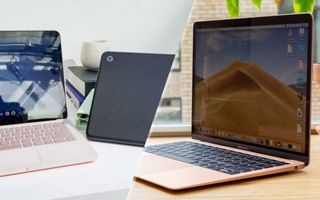
Apple's newest MacBook Air is a fine machine, flaunting a beautiful chassis and bright display, but the ultraportable laptop has a few shortcomings that could make some people convert to Chromebooks. Google's original Pixelbook ($999) is one of the best Chromebooks around but was a tough sell because of its sky-high price. Now the Pixelbook Go ($649) has arrived at a lower cost but with many of the same features --- a slim chassis, a comfortable, quiet keyboard, and even newer processors --- making it an even more compelling alternative to the recently updated MacBook Air.
Google could finally have a MacBook Air killer in its ranks, but can the Pixelbook Go really take down the giant? Read on to find out.
Pixelbook Go vs MacBook Air: Specs Compared
| Google Pixelbook Go | MacBook Air | |
| Starting Price | $649 | $999 |
| Colors | Matte silver/pink or matte black | Space Gray, Silver, Gold |
| Display | 13.3-inch, 1080p or 4K touch screen | 13.3-inch, 2560 x 1600-pixel (non-touch) |
| CPU | Up to 8th Gen Core i7 (Y-series) | Intel 8th Gen Core i5 (Y-series) |
| RAM | Up to 16GB | Up to 16GB |
| SSD | Up to 256GB | up to 1TB |
| Ports | 2 USB-C, headphone/mic | 2 USB Type-C, headphone/mic |
| Size | 12.2 x 8.1 x 0.5 inches thin | 12 x 8.4 x 0.6 inches |
| Weight | 2 pounds | 2.8 pounds |
Pricing
Google's Pixelbook Go starts at $649, or $450 less than the base MacBook Air. The least expensive Pixelbook Go has a Core m3 CPU, 8GB of RAM and a 64GB SSD. A more comparable configuration to the base MacBook Air is the $849 Pixelbook Go, which has a Core i5 CPU, 8GB of RAM and a 128GB SSD.
Stay in the know with Laptop Mag
Get our in-depth reviews, helpful tips, great deals, and the biggest news stories delivered to your inbox.
Doubling memory to 16GB raises the price of the Pixelbook Go to $999. The only configuration that costs more than any MacBook Air is 4K version of the Pixelbook Go, which has a Core i7 CPU, 16GB of RAM and a 256GB SSD.
Apple's products are expensive. The MacBook Air with a Core i5 CPU, 8GB of RAM and a 128GB SSD costs a hefty $1,099. Increasing the storage capacity to 256GB raises the price to $1,299. Bumping RAM up to 16GB costs another $200 and you'll pay the same amount every time you double the storage (up to 1TB).
Design
These laptops are all about portability, but the Pixelbook Go, at just 2 pounds and 0.5 inches, is easier to carry around than the MacBook Air (2.8 pounds, 0.6 inches). That incredible lightness can be attributed to the Pixelbook Go's magnesium alloy chassis.
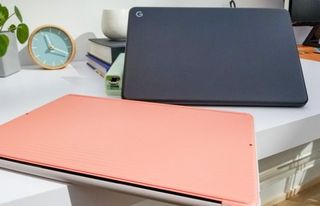
Laptop makers are starting to favor magnesium alloy because of how light yet durable the material is. In our experience, laptops made of the material can hollow and insubstantial compared to aluminum laptops like the MacBook Air. We haven't had enough time with the Pixelbook Go to make that claim but it's something to think about.

Unlike the Pixelbook, the Pixelbook Go is a clamshell laptop, not a convertible 2-in-1. And unlike its predecessor, the Pixelbook Go has a playful design complete with rounded corners, a soft-touch finish, and a bizarre "grippable" grooved underside. If you really want to embrace Google's lighthearted approach, we recommend the "Not Pink" color scheme, which has a soft pink lid and deck and a vivid coral-colored bottom panel. Prefer something more classy? There's also an all-black version.

Apple hasn't strayed far from the MacBook Air design it revealed almost a decade ago. Even when the company updated the MacBook Air in 2018 to have slimmer bezels and a more compact chassis. That means the 2019 MacBook Air is still a slim aluminum wedge with a black keyboard and a chrome Apple logo centered in the lid.
The MacBook Air is available in Space Gray, Silver and a fancy Gold version we tested.
Both devices have speakers grills flanking their keyboards. We were pleased with the sound produced by the MacBook Air and expect good things from the Pixelbook Go.
Ports
Make sure to buy some dongles at checkout. These laptops support very few connections.

You get just a headphone jack and dual USB-C ports on both the Pixelbook Go and MacBook Air.
Display
The Pixelbook Go has a 13.3-inch touch screen available in 1080p or 4K resolution.
That means the Pixelbook's display has a traditional aspect ratio of 16:9, not the more reading-friendly 3:2 aspect ratio found on the Pixelbook.
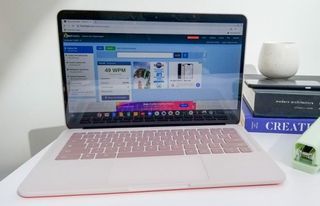
We haven't been able to test the Pixelbook Go's displays yet but found the 1080p screen to be fairly bright and decently vivid in our hands-on time with the laptop.
It will need to be a good panel if it's going to outdo the MacBook Air's display. Our colorimeter measured the MacBook Air's screen at 100% of the sRGB color spectrum, which is a good result but less than the 129% premium laptop average.
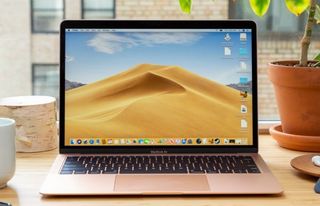
The MacBook Air's panel also peaked at 343 nits of brightness, which is just short of the premium laptop average (346 nits), but, again, a good result.
New to this year's MacBook Air is True Tone, which adjusts the color of your display based on ambient lighting.
Performance
The Pixelbook Go is available with 8th Gen Intel Core m3, Core i5 and Core i7 CPUs and up to 16GB of RAM.
While we don't know the specific processors models, the Pixelbook Go will employ Y-series chips, just like the MacBook Air. Y-series processors are low-power chip meant thin and light laptops. They typically enable long battery life but at the expense of performance.

The Pixelbook Go and MacBook Air likely use the same chips so expect similar performance between these two notebooks. At least, when they're configured with the same specs.
Apple only offers the MacBook Air with an 8th Gen Core i5 CPU. That means the base Pixelbook Go (with a Core m3 CPU) will likely underperform against the MacBook Air while the pricey Core i7 Pixelbook Go should be faster than the Apple laptop.
It's worth noting that the Pixelbook Go comes with up to a 256GB SSD whereas the MacBook Air can be configured with a 1TB SSD. Of course, the Pixelbook Go runs Chrome OS so most of your files will be saved in the cloud.
Keyboard
Anything is better than the MacBook Air's keyboard at this point. It's not so much that they're shallow (which they very much are) but that they've proven to be unreliable. So much so that Apple had to apologize for its butterfly-style switches and launched a free repair program for affected keys and keyboards.
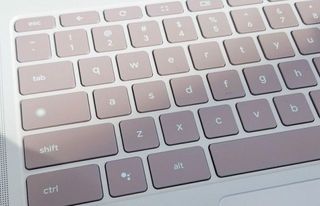
Google is using new "Hush Keys" to keep the Pixelbook Go's keyboard quiet. While we can confirm that these work as advertised, the keyboard itself is shallow and we bottomed out every time we typed on it. We also wish the Pixelbook Go's keys had more pop.
Battery life
The Pixelbook Go's battery life is rated at 12 hours, an impressive runtime if it holds up a real-world workload. We're suspicious of that claim considering Google rates the Pixelbook's runtime at 10 hours but the laptop lasted only 7 hours and 43 minutes on our battery test.
We'll put the Pixelbook Go through our rigorous battery test once we get a review unit. If it wants to outlast the MacBook Air, it will need to stay powered for longer than 8 hours and 51 minutes.
If you can ignore the differences between Chrome OS and macOS Catalina, the Pixelbook Go and MacBook Air are two very similar devices. Both laptops are extremely portable, they use the same 8th Gen Y-series processors, they each have shallow keyboards and they should offer long battery life (we still need to test the Pixelbook Go to be sure). Heck, they even have the same ports.

What isn't so similar about these laptops is their price. Starting at $649, the Pixelbook Go costs significantly less than the MacBook Air, which starts at $1,099. Even a comparable-specced Pixelbook Go saves you hundreds off the price of the MacBook Air, and that's despite it having a touch screen.
We still need to test the Pixelbook Go to see how its display, keyboard, build quality and performance hold up to the MacBook Air. But on paper, Google's new Chromebook looks to be a winner.
Phillip Tracy is the assistant managing editor at Laptop Mag where he reviews laptops, phones and other gadgets while covering the latest industry news. After graduating with a journalism degree from the University of Texas at Austin, Phillip became a tech reporter at the Daily Dot. There, he wrote reviews for a range of gadgets and covered everything from social media trends to cybersecurity. Prior to that, he wrote for RCR Wireless News covering 5G and IoT. When he's not tinkering with devices, you can find Phillip playing video games, reading, traveling or watching soccer.

